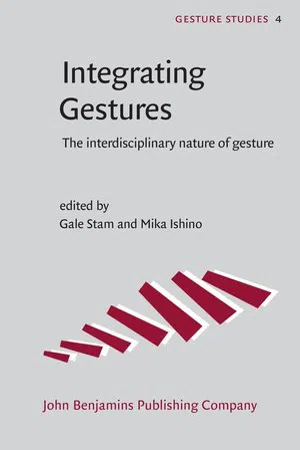
- English
- PDF
- Available on iOS & Android
Integrating Gestures : The Interdisciplinary Nature of Gesture
About this book
Gestures convey information about culture, discourse, thought, intentionality, emotion, intersubjectivity, cognition, and first and second language acquisition. Additionally, they are used by non-human primates to communicate with their peers and with humans. Consequently, the modern field of gesture studies has attracted researchers from a number of different disciplines such as anthropology, cognitive science, communication, neuroscience, psycholinguistics, primatology, psychology, robotics, sociology and semiotics. This volume presents an overview of the depth and breadth of current research in gesture. Its focus is on the interdisciplinary nature of gesture. The chapters included in the volume are divided into six themes: the nature and functions of gesture, first language development and gesture, second language effects on gesture, gesture in the classroom and in problem solving, gesture aspects of discourse and interaction, and gestural analysis of music and dance.
Frequently asked questions
- Essential is ideal for learners and professionals who enjoy exploring a wide range of subjects. Access the Essential Library with 800,000+ trusted titles and best-sellers across business, personal growth, and the humanities. Includes unlimited reading time and Standard Read Aloud voice.
- Complete: Perfect for advanced learners and researchers needing full, unrestricted access. Unlock 1.4M+ books across hundreds of subjects, including academic and specialized titles. The Complete Plan also includes advanced features like Premium Read Aloud and Research Assistant.
Please note we cannot support devices running on iOS 13 and Android 7 or earlier. Learn more about using the app.
Information
Table of contents
- Integrating Gestures
- Editorial page
- Title page
- LCC data
- Table of contents
- Part I. Nature and functions of gestures
- Chapter 1. Introduction
- Chapter 2. Addressing the problems of intentionality and granularity in non-human primate gesture
- Chapter 3. Birth of a Morph
- Chapter 4. Dyadic evidence for grounding with abstract deictic gestures
- Chapter 5. If you don’t already know, I’m certainly not going to show you!
- Chapter 6. Measuring the formal diversity of hand gestures by their hamming distance
- Chapter 7. ‘Parallel gesturing’ in adult-child conversations
- Part II. First language development and gesture
- Chapter 8. Sentences and conversations before speech?
- Chapter 9. Giving a nod to social cognition
- Chapter 10. Sensitivity of maternal gesture to interlocutor and context
- Chapter 11. The organization of children’s pointing stroke endpoints
- Chapter 12. Is there an iconic gesture spurt at 26 months?
- Chapter 13. The development of spatial perspective in the description of large-scale environments
- Chapter 14. Learning to use gesture in narratives
- Chapter 15. The changing role of gesture form and function in a picture book interaction between a child with autism and his support teacher
- Part III. Second language effects on gesture
- Chapter 16. A cross-linguistic study of verbal and gestural descriptions in French and Japanese monolingual and bilingual children
- Chapter 17. Gesture and language shift on the Uruguayan-Brazilian border
- Part IV. Gesture in the classroom and in problem-solving
- Chapter 18. Seeing the graph vs. being the graph
- Chapter 19. How gesture use enables intersubjectivity in the classroom
- Chapter 20. Microgenesis of gestures during mental rotation tasks recapitulates ontogenesis
- Part V. Gesture aspects of discourse and interaction
- Chapter 21. Gesture and discourse
- Chapter 22. Speakers’ use of ‘action’ and ‘entity’ gestures with definite and indefinite references
- Chapter 23. “Voices” and bodies
- Chapter 24. Gestures in overlap
- Part VI. Gestural analysis of music and dance
- Chapter 25. Music and leadership
- Chapter 26. Handjabber
- Name index
- Subject index